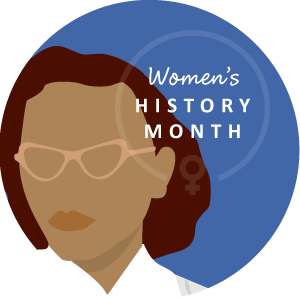
Women’s History Month
Women’s History Month is the perfect time to look at contributions made by women to the field of public health. Women have played an important role in bettering the lives of others, whether through important vaccines, critical research, or advocating for public health measures in their community. These are just a few of the women who have played a critical role in public health throughout history, or shall we say herstory:

Annie Dodge Wauneka
Annie Dodge Wauneka was part of the Navajo Nation tribe, which now covers parts of Arizona, New Mexico, and Utah. She played an instrumental role in helping her tribe understand public health measures and worked to help eradicate Tuberculous while she served as the first woman on the Tribal Council in 1951. She also translated English medical terms into Navajo so that her tribe could better understand them and not fear modern medicine, like vaccines.
She served on the advisory boards for the U.S Surgeon General and the United States Public Health Service and was the first Native American to be awarded the Presidential Medal of Freedom in 1963.

Dr. Alice Hamilton
Dr. Alice Hamilton spent the majority of her life studying toxicology and how certain metals and chemicals could affect a person’s health in the workplace, also known as industrial toxicology. She pushed for safer working conditions by sharing the dangers of working with certain toxins, primarily lead, and served as the only woman of the League of Nations Health Committee from 1924 to 1930.
Her work in the field of public health was later commemorated on a U.S postal stamp in 1995 as she is considered a pioneer of industrial toxicology.

Dr. Anne Szarewski
Ann Szarewski, M.D. was one of the first researchers to determine a link between the Human Papilloma Virus (HPV) and cervical cancer, showing that HPV could cause cervical cancer. At the time, cervical cancer was one of the leading causes of cancer deaths in women.
In a paper she and her colleagues published in 1995, Szarewski showed that the HPV virus could cause precancerous cells and that it should be looked for when examining a pap smear sample, as it was previously not. Her research also spurred the development of the first HPV vaccine in 2006, Gardasil, which she played a role in the development of.

Dr. Jane Hinton
If the last name "Hinton" sounds familiar to you, it's probably because her dad, William Hinton, was featured in our Black History Month blog! Jane worked in her father's lab after college and was an assistant to John Howard Mueller in the bacteriology and immunology department at Harvard University.
It was there that both Mueller and Hinton discovered the Mueller-Hinton Agar, a petri dish culture where bacteria could thrive. They used this culture to determine the effectiveness of antibiotics when placed in the petri dish or "agar.” This method is primally used today to test on nonfastidious bacteria, like strep and staph.
From Past to Present
There are (and have been) so many incredible women who have helped pave the way in the field of public health. One group of women we want to make sure to include are the current public health nurses, doctors, caregivers, and first responders who have been working on the frontlines during this pandemic. Their commitment to caring for others has been one of the biggest roles during this pandemic, and we appreciate their efforts greatly.
Want to learn about more women in public health? Check out the women we highlighted last month in our Black History Month blog!
